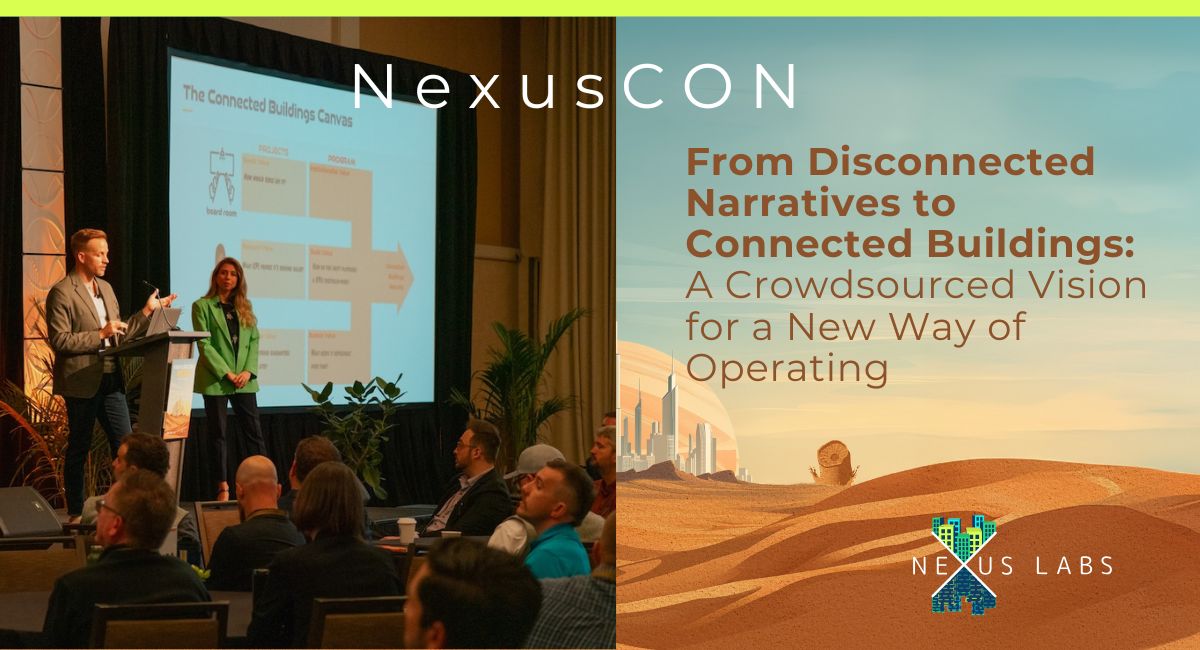
How a sci-fi story about controlling narrative can become a framework for measuring and scaling building programs
James Dice opened NexusCon 2025 with a confession: he really loves Dune.
He's seen both movies. He's read the first two books. And he asked the room: who's seen the first film? Lots of hands. Who's seen both? Fewer hands. Who's read all the books?
A handful of uber-fans raised their hands proudly.
"Okay, you win," Dice laughed.
For the next hour, the Founder of Nexus Labs was going to use Frank Herbert's science fiction epic about power, prophecy, and desert survival to explain what's broken in the smart buildings industry. And judging by the number of people who came up to him afterward to talk about Dune—way more passionate than him, he admitted—the metaphor resonated.
"If you control the story, you control the future," Dice told the audience gathered in Denver. "And right now, our industry is living in disconnected stories."
It's an audacious analogy. But after two days of case studies, debates, and conversations with building owners from Princeton to Microsoft, the metaphor landed. The smart buildings movement hasn't failed because the technology doesn't work. It's struggled because we've been telling the wrong stories—or rather, too many disconnected ones—about what this technology actually does and why it matters.
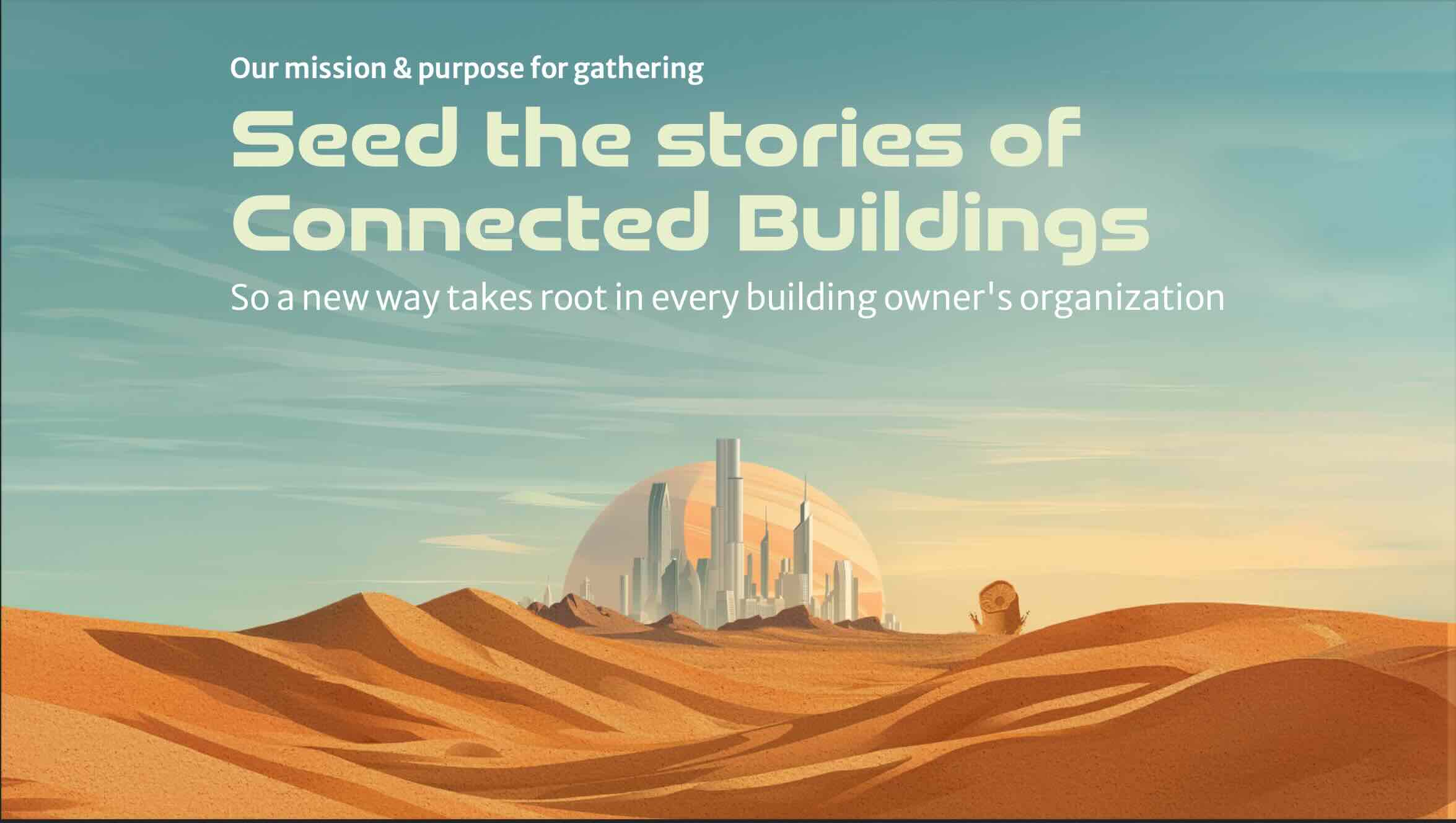
For those unfamiliar with Dune, here's what you need to know: In Herbert's universe, a secretive order of women called the Bene Gesserit wields immense influence—not through armies or wealth, but through carefully seeded myths. For centuries, they planted prophecies across different cultures, knowing that when the right moment arrived, those stories would make their agenda feel like destiny.
When Paul Atreides arrives on the desert planet Arrakis, the indigenous Fremen don't see an outsider—they see the fulfillment of prophecy. The groundwork was laid generations earlier. The story was already written.
This, Dice argued, is what the smart buildings industry needs to learn. Not manipulation, but the strategic planting of a narrative that connects disparate outcomes—energy efficiency, occupant health, operational resilience, carbon reduction—into one coherent story that resonates from the boiler room to the boardroom.
"We're the slightly less creepy version of the Bene Gesserit for the real estate industry," Dice joked. But the point was serious: transformation doesn't happen through isolated pilots. It happens when a new way of operating feels inevitable.
The smart buildings conversation has always been fragmented. Dice walked through the industry's evolution as a series of disconnected waves:
Each wave mattered. Each drove real value. But none unified the conversation around a single operating model. Energy teams talked past IT teams. Facility managers operated in silos from sustainability leads. Executives heard buzzwords but didn't see a coherent strategy.
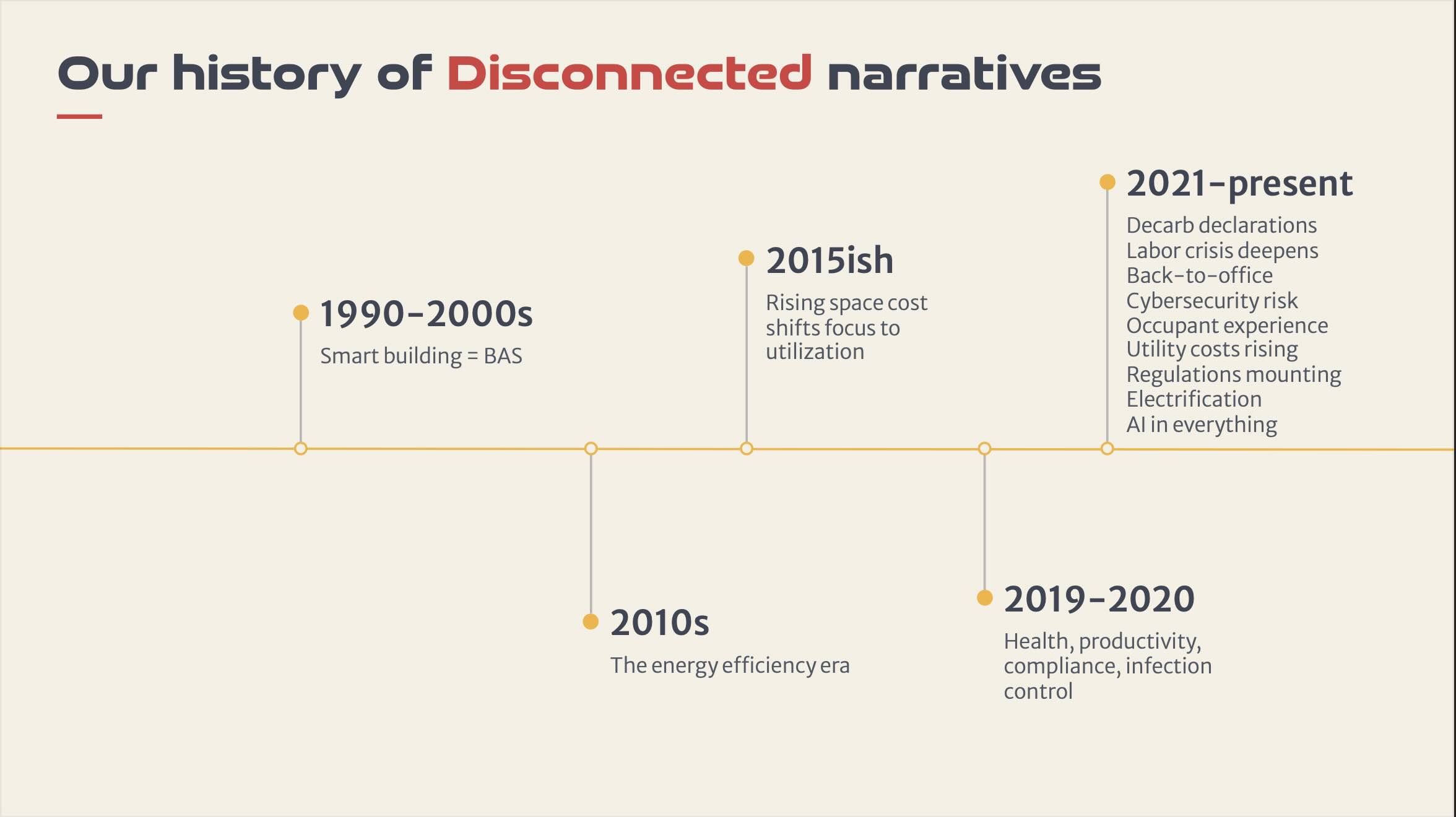
"The problem isn't that these narratives were wrong," Dice said. "The problem is they're still disconnected. Technology stories here, energy stories over there, health stories in another silo."
Rosy Khalife, Co-Founder of Nexus Labs, reinforced the urgency: "No matter who you are in this room—owner, service provider, vendor—you can get behind this new way of operating our buildings."
So what does a connected narrative look like? Not a buzzword, but a framework that unifies outcomes building owners already care about:
These aren't new goals. But they've rarely been presented as parts of the same program. When they are, something shifts. Suddenly, the “smart buildings” pitch isn't about installing a new software platform—it's about embedding a new operating model that delivers measurable, enterprise-level value.
This is where Dice introduced the heart of his keynote: the Three Precepts of Connected Buildings.
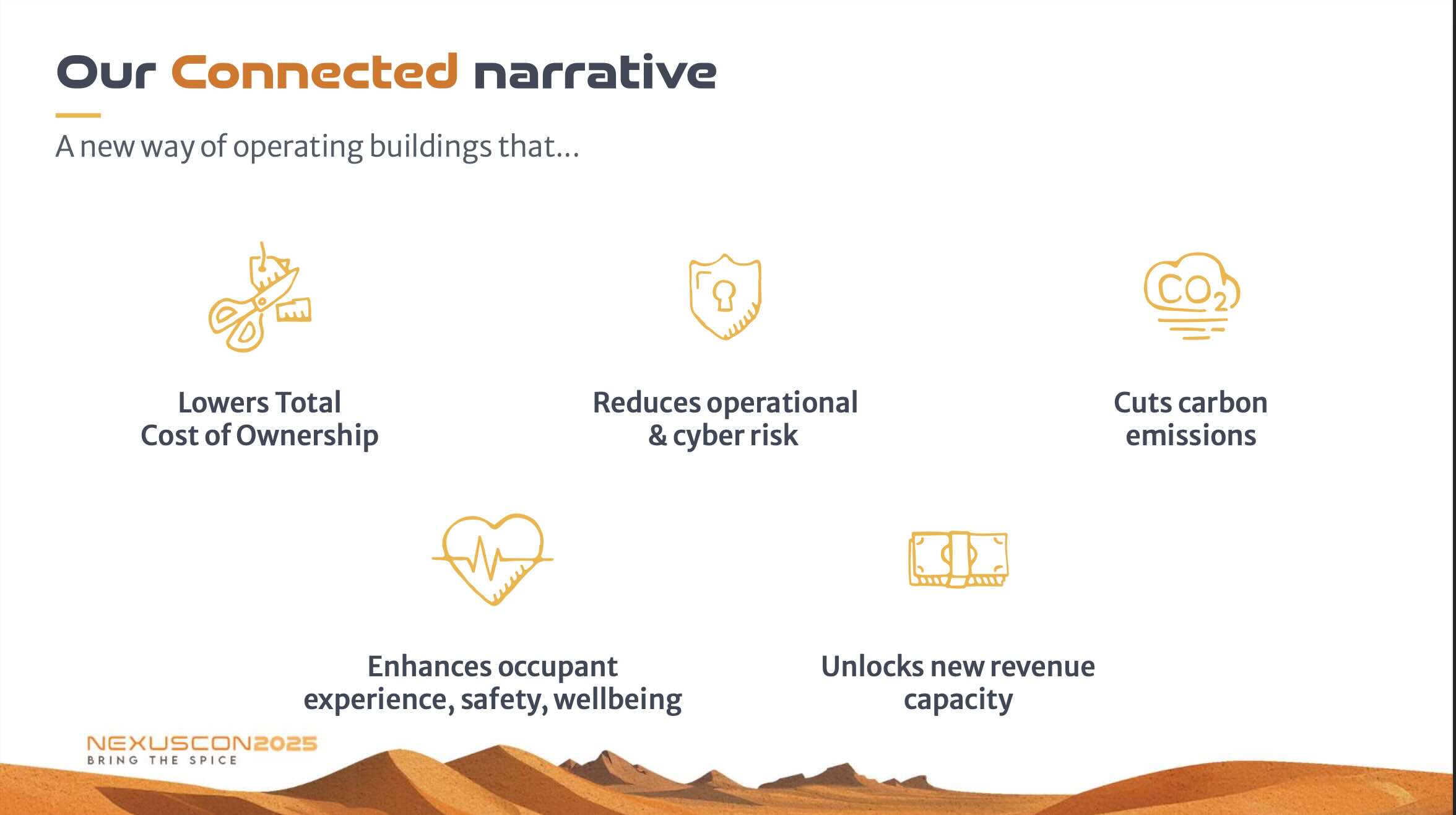
Smart buildings conversations fail when they don't speak the language of the boardroom. Terms like "fault detection" or "data normalization" mean nothing to a CFO. But "fewer tenant complaints," or "higher lease renewal rates"? Those translate.
"It's our job to speak what this means to them," Dice said. "Not smart buildings—enterprise value."
This precept mirrors the Bene Gesserit's "Voice"—a power that compels action not through force, but through speaking in a way that resonates so deeply, the listener has no choice but to respond. For building owners, that means translating technical improvements into business outcomes the C-suite already cares about.
For landlords, it might mean positioning a smart buildings program as a tool to make properties easier to lease. For occupiers like corporate real estate teams, it might mean framing the same program as a way to reduce operational risk and improve workplace experience. Same technology. Different story. Both true.
Speaking value isn't enough. You have to prove it—with KPIs the organization trusts and can trace back to the program.
Dice referenced the Gom Jabbar test from Dune—a pass-or-fail trial that measures what someone is truly made of. In the same way, building owners need measurable proof that their connected buildings programs deliver on their promises.
"It's not enough to say the building is healthier or uses less carbon," Dice said. "We have to prove it with KPIs the organization trusts."
Examples include:
The key is specificity. Vague claims about "better performance" don't cut it. Precise, measurable targets tied to business outcomes do.
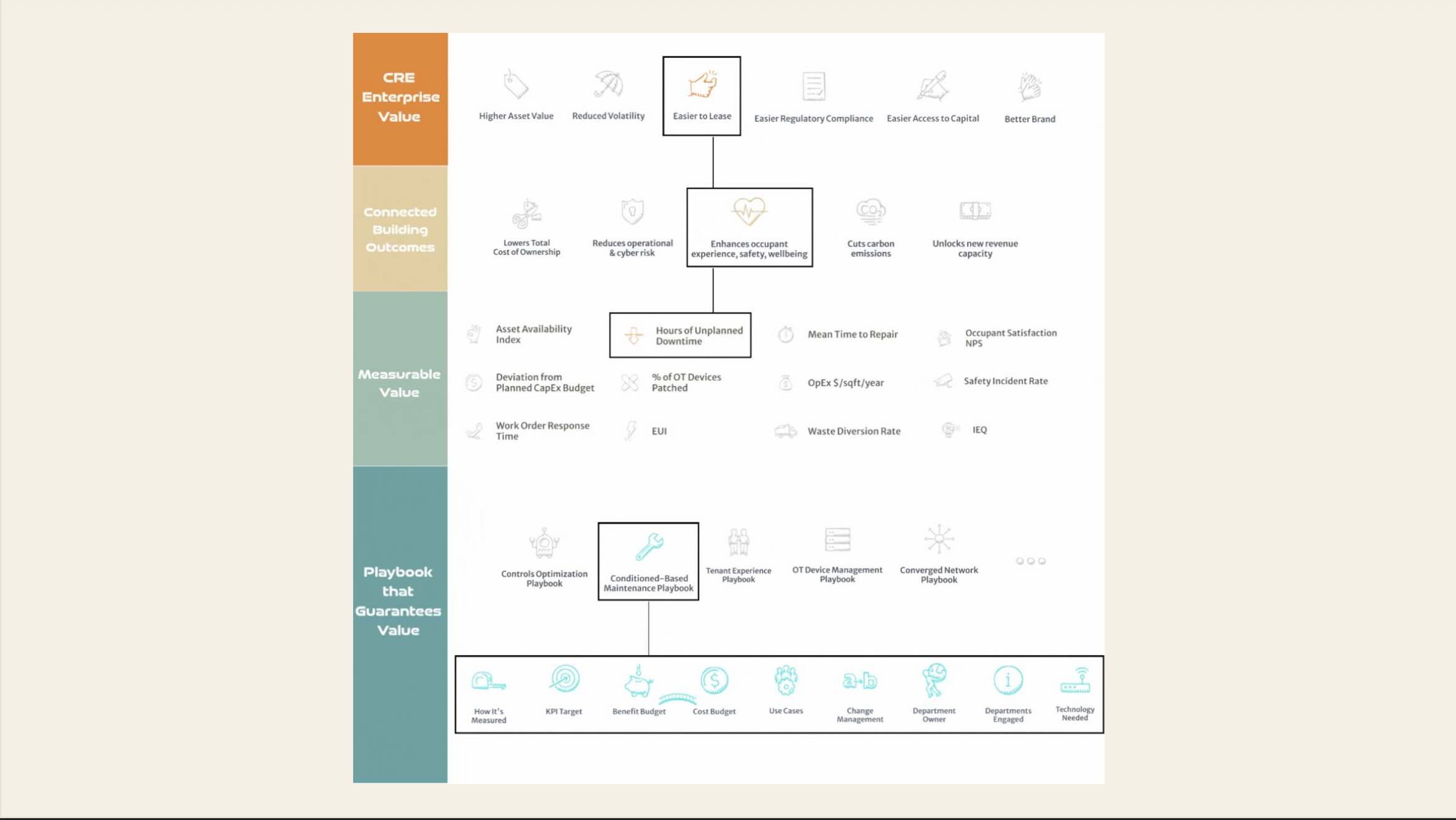
Once you know what to measure, the next question is: how do you guarantee you'll hit it? This is where playbooks come in.
Dice used the Fremen from Dune as his analogy. These desert people survive on the harshest planet in the galaxy not through luck, but through proven, repeatable practices refined over centuries. They wear stillsuits that recycle moisture. They walk in specific patterns to avoid attracting sandworms. They have playbooks for survival in an environment where failure isn't an option.
"This is what we need," Dice said. "Playbooks that spell out exactly how value is created—how success is measured, what the target is, who owns it, what departments are engaged, what technology is required. Playbooks make outcomes repeatable instead of one-off wins."
He acknowledged that some owners still see connected buildings projects as risky. But many vendors at NexusCon have now deployed their solutions thousands of times. Their playbooks are proven. The question is whether owners are ready to adopt them—and whether vendors are ready to make those playbooks consistent, transparent, measurable, and tied to guaranteed outcomes.
The three precepts—common language, measured value, proven playbooks—form the foundation. But how do you actually implement them? How do you turn philosophy into practice?
Enter the Connected Buildings Canvas, a six-question framework Dice introduced to help owners, vendors, and service providers think systematically about program maturity.

The canvas is organized into two columns: Projects (one-time initiatives) and Program (sustained, institutionalized value creation).
Projects:
Program:
The canvas isn't prescriptive. It's diagnostic. It helps identify where a program is strong and where it needs work. And critically, it acknowledges that maturity isn't binary. Programs move through these stages over time, evolving from isolated projects into institutionalized operating models.
The closing keynote brought the framework to life with examples from building owners who presented at NexusCon.
April Yi, Digital Transformation and Cybersecurity Champion with CBRE at Microsoft, shared how her organization created a "Fault Derby"—a program that incentivizes technicians to close out faults identified by analytics software. Technicians earn cash bonuses based on the verified, annualized savings from the issues they fix.
The result? An estimated $1.7 million in energy savings, funded in part by the client because the ROI was undeniable. More importantly, the program is sustainable—technicians ask each other how to earn bonuses, creating peer-driven adoption.
"We had data to benchmark, so we could calculate those savings," April explained. "And we had people in place to program manage it—to track metrics, follow up with technicians, and campaign the program."
This is what a playbook that guarantees value looks like. April was inspired by a presentation in 2024’s NexusCon by Devan Tracy to try this.
Andrew Knueppel and Cristal Ortiz from LinkedIn described how they embedded performance KPIs into their facility management contract renewal. A portion of the vendor's management fee is now at risk, tied to objective metrics like proactive work order completion rates.
The metrics come from Clockworks Analytics, which LinkedIn uses across its U.S. portfolio. The insight was that technology alone doesn't sustain change—contracts do.
"We moved from subjective KPIs to measurable ones," Andrew said. "And the fee-at-risk component makes performance sustainable over time."
They couldn't implement this immediately—the vendor was already under contract. But when the renewal came up, they had their opportunity to institutionalize the change.
Brendan Robinson, from Glenstone Museum, built a compliance dashboard to track whether environmental conditions in art spaces remained within strict temperature and humidity requirements. Leadership generally cared about one thing above all else: whether the art was being kept safe by keeping the spaces at setpoint. The dashboard answered that question transparently.
The museum uses Schneider Electric's Building Advisor (a white-labeled version of Clockworks Analytics) to monitor conditions in real time. Brendan's insight was about choosing the right KPI.
"We showed the last 24 hours, last month, last 90 days," Brendan said. "It proved our team was doing a great job—and gave engineers recognition for their work."
The original vendor had proposed a different KPI. Brendan changed it to focus on compliance, which better reflected the actual value the program needed to prove.
Steven Burrell, from Northern Arizona University, explained how his team extracted data from their data layer platform and shared it with the campus sustainability team, researchers, and instructors across campus. The building systems became a "living lab"—preparing students for careers in the field while supporting faculty research.
NAU uses Willow as the application layer sitting on top of Mapped, which provides the underlying data infrastructure. The combination lets them expose building data to multiple departments without recreating integrations for each use case.
"It's our data," Steve said. "We can do what we need to do with it." By scaling access across departments, NAU embedded the program into the university's broader mission.
Tim Cook, from Goldman Sachs, described how his team integrated smart buildings initiatives into procurement processes, creating transparency and accountability at every level.
Goldman Sachs uses KODE Labs and Armis as part of their connected buildings infrastructure. But Tim's presentation focused on something more fundamental than technology—how governance and transparency create accountability that scales across an entire program.
"Everything we do fits into this program and allows us to do it very transparently, very quickly, and at massive scale," Tim said. "There's a comfort in knowing how stakeholders are looking at the program at all times—at their level."
When asked how his bosses would describe the program, Tim answered: "They would say it's very transparent. It took a long time to get here, but we've been able to contextualize it and tie it back to compliance, budgets, and value."
This is what institutionalized value looks like—when the program dissolves into the business itself, shaping contracts, roles, and organizational structure.
At the closing keynote, Dice returned to the Dune metaphor one last time.
"We're not ending the Connected Buildings concept this year," he said. "We're integrating it into everything we do."
The goal isn't to create a buzzword. It's to create a management philosophy—a way of operating buildings that aligns technology, people, and process around measurable outcomes that matter to the enterprise.
Owners who measure, communicate, and standardize value creation will outperform their peers. The shift isn't just technical. It's cultural.
And it's already happening. NexusCon 2025 featured 100 building owner organizations—from Stanford University to the City of San Diego. These aren't visionaries waiting for the future. They're practitioners writing it, one playbook at a time.
The smart buildings movement isn't waiting for destiny. It's being written by the people willing to connect their stories.
The Bene Gesserit seeded prophecies for generations, knowing that when the right moment came, the story would feel inevitable. Building owners have that same opportunity now.
The narrative is shifting. The playbooks are proven. The canvas is available.
---
Download the Connected Buildings Canvas.
Register for upcoming NexusCast: The State of Connected OT (December 10, 2025) – focused learning on smart buildings, cybersecurity and networking, without the travel.
Sign up for Nexus Pro - Full NexusCon video bundle included.
How a sci-fi story about controlling narrative can become a framework for measuring and scaling building programs
James Dice opened NexusCon 2025 with a confession: he really loves Dune.
He's seen both movies. He's read the first two books. And he asked the room: who's seen the first film? Lots of hands. Who's seen both? Fewer hands. Who's read all the books?
A handful of uber-fans raised their hands proudly.
"Okay, you win," Dice laughed.
For the next hour, the Founder of Nexus Labs was going to use Frank Herbert's science fiction epic about power, prophecy, and desert survival to explain what's broken in the smart buildings industry. And judging by the number of people who came up to him afterward to talk about Dune—way more passionate than him, he admitted—the metaphor resonated.
"If you control the story, you control the future," Dice told the audience gathered in Denver. "And right now, our industry is living in disconnected stories."
It's an audacious analogy. But after two days of case studies, debates, and conversations with building owners from Princeton to Microsoft, the metaphor landed. The smart buildings movement hasn't failed because the technology doesn't work. It's struggled because we've been telling the wrong stories—or rather, too many disconnected ones—about what this technology actually does and why it matters.

For those unfamiliar with Dune, here's what you need to know: In Herbert's universe, a secretive order of women called the Bene Gesserit wields immense influence—not through armies or wealth, but through carefully seeded myths. For centuries, they planted prophecies across different cultures, knowing that when the right moment arrived, those stories would make their agenda feel like destiny.
When Paul Atreides arrives on the desert planet Arrakis, the indigenous Fremen don't see an outsider—they see the fulfillment of prophecy. The groundwork was laid generations earlier. The story was already written.
This, Dice argued, is what the smart buildings industry needs to learn. Not manipulation, but the strategic planting of a narrative that connects disparate outcomes—energy efficiency, occupant health, operational resilience, carbon reduction—into one coherent story that resonates from the boiler room to the boardroom.
"We're the slightly less creepy version of the Bene Gesserit for the real estate industry," Dice joked. But the point was serious: transformation doesn't happen through isolated pilots. It happens when a new way of operating feels inevitable.
The smart buildings conversation has always been fragmented. Dice walked through the industry's evolution as a series of disconnected waves:
Each wave mattered. Each drove real value. But none unified the conversation around a single operating model. Energy teams talked past IT teams. Facility managers operated in silos from sustainability leads. Executives heard buzzwords but didn't see a coherent strategy.

"The problem isn't that these narratives were wrong," Dice said. "The problem is they're still disconnected. Technology stories here, energy stories over there, health stories in another silo."
Rosy Khalife, Co-Founder of Nexus Labs, reinforced the urgency: "No matter who you are in this room—owner, service provider, vendor—you can get behind this new way of operating our buildings."
So what does a connected narrative look like? Not a buzzword, but a framework that unifies outcomes building owners already care about:
These aren't new goals. But they've rarely been presented as parts of the same program. When they are, something shifts. Suddenly, the “smart buildings” pitch isn't about installing a new software platform—it's about embedding a new operating model that delivers measurable, enterprise-level value.
This is where Dice introduced the heart of his keynote: the Three Precepts of Connected Buildings.

Smart buildings conversations fail when they don't speak the language of the boardroom. Terms like "fault detection" or "data normalization" mean nothing to a CFO. But "fewer tenant complaints," or "higher lease renewal rates"? Those translate.
"It's our job to speak what this means to them," Dice said. "Not smart buildings—enterprise value."
This precept mirrors the Bene Gesserit's "Voice"—a power that compels action not through force, but through speaking in a way that resonates so deeply, the listener has no choice but to respond. For building owners, that means translating technical improvements into business outcomes the C-suite already cares about.
For landlords, it might mean positioning a smart buildings program as a tool to make properties easier to lease. For occupiers like corporate real estate teams, it might mean framing the same program as a way to reduce operational risk and improve workplace experience. Same technology. Different story. Both true.
Speaking value isn't enough. You have to prove it—with KPIs the organization trusts and can trace back to the program.
Dice referenced the Gom Jabbar test from Dune—a pass-or-fail trial that measures what someone is truly made of. In the same way, building owners need measurable proof that their connected buildings programs deliver on their promises.
"It's not enough to say the building is healthier or uses less carbon," Dice said. "We have to prove it with KPIs the organization trusts."
Examples include:
The key is specificity. Vague claims about "better performance" don't cut it. Precise, measurable targets tied to business outcomes do.

Once you know what to measure, the next question is: how do you guarantee you'll hit it? This is where playbooks come in.
Dice used the Fremen from Dune as his analogy. These desert people survive on the harshest planet in the galaxy not through luck, but through proven, repeatable practices refined over centuries. They wear stillsuits that recycle moisture. They walk in specific patterns to avoid attracting sandworms. They have playbooks for survival in an environment where failure isn't an option.
"This is what we need," Dice said. "Playbooks that spell out exactly how value is created—how success is measured, what the target is, who owns it, what departments are engaged, what technology is required. Playbooks make outcomes repeatable instead of one-off wins."
He acknowledged that some owners still see connected buildings projects as risky. But many vendors at NexusCon have now deployed their solutions thousands of times. Their playbooks are proven. The question is whether owners are ready to adopt them—and whether vendors are ready to make those playbooks consistent, transparent, measurable, and tied to guaranteed outcomes.
The three precepts—common language, measured value, proven playbooks—form the foundation. But how do you actually implement them? How do you turn philosophy into practice?
Enter the Connected Buildings Canvas, a six-question framework Dice introduced to help owners, vendors, and service providers think systematically about program maturity.

The canvas is organized into two columns: Projects (one-time initiatives) and Program (sustained, institutionalized value creation).
Projects:
Program:
The canvas isn't prescriptive. It's diagnostic. It helps identify where a program is strong and where it needs work. And critically, it acknowledges that maturity isn't binary. Programs move through these stages over time, evolving from isolated projects into institutionalized operating models.
The closing keynote brought the framework to life with examples from building owners who presented at NexusCon.
April Yi, Digital Transformation and Cybersecurity Champion with CBRE at Microsoft, shared how her organization created a "Fault Derby"—a program that incentivizes technicians to close out faults identified by analytics software. Technicians earn cash bonuses based on the verified, annualized savings from the issues they fix.
The result? An estimated $1.7 million in energy savings, funded in part by the client because the ROI was undeniable. More importantly, the program is sustainable—technicians ask each other how to earn bonuses, creating peer-driven adoption.
"We had data to benchmark, so we could calculate those savings," April explained. "And we had people in place to program manage it—to track metrics, follow up with technicians, and campaign the program."
This is what a playbook that guarantees value looks like. April was inspired by a presentation in 2024’s NexusCon by Devan Tracy to try this.
Andrew Knueppel and Cristal Ortiz from LinkedIn described how they embedded performance KPIs into their facility management contract renewal. A portion of the vendor's management fee is now at risk, tied to objective metrics like proactive work order completion rates.
The metrics come from Clockworks Analytics, which LinkedIn uses across its U.S. portfolio. The insight was that technology alone doesn't sustain change—contracts do.
"We moved from subjective KPIs to measurable ones," Andrew said. "And the fee-at-risk component makes performance sustainable over time."
They couldn't implement this immediately—the vendor was already under contract. But when the renewal came up, they had their opportunity to institutionalize the change.
Brendan Robinson, from Glenstone Museum, built a compliance dashboard to track whether environmental conditions in art spaces remained within strict temperature and humidity requirements. Leadership generally cared about one thing above all else: whether the art was being kept safe by keeping the spaces at setpoint. The dashboard answered that question transparently.
The museum uses Schneider Electric's Building Advisor (a white-labeled version of Clockworks Analytics) to monitor conditions in real time. Brendan's insight was about choosing the right KPI.
"We showed the last 24 hours, last month, last 90 days," Brendan said. "It proved our team was doing a great job—and gave engineers recognition for their work."
The original vendor had proposed a different KPI. Brendan changed it to focus on compliance, which better reflected the actual value the program needed to prove.
Steven Burrell, from Northern Arizona University, explained how his team extracted data from their data layer platform and shared it with the campus sustainability team, researchers, and instructors across campus. The building systems became a "living lab"—preparing students for careers in the field while supporting faculty research.
NAU uses Willow as the application layer sitting on top of Mapped, which provides the underlying data infrastructure. The combination lets them expose building data to multiple departments without recreating integrations for each use case.
"It's our data," Steve said. "We can do what we need to do with it." By scaling access across departments, NAU embedded the program into the university's broader mission.
Tim Cook, from Goldman Sachs, described how his team integrated smart buildings initiatives into procurement processes, creating transparency and accountability at every level.
Goldman Sachs uses KODE Labs and Armis as part of their connected buildings infrastructure. But Tim's presentation focused on something more fundamental than technology—how governance and transparency create accountability that scales across an entire program.
"Everything we do fits into this program and allows us to do it very transparently, very quickly, and at massive scale," Tim said. "There's a comfort in knowing how stakeholders are looking at the program at all times—at their level."
When asked how his bosses would describe the program, Tim answered: "They would say it's very transparent. It took a long time to get here, but we've been able to contextualize it and tie it back to compliance, budgets, and value."
This is what institutionalized value looks like—when the program dissolves into the business itself, shaping contracts, roles, and organizational structure.
At the closing keynote, Dice returned to the Dune metaphor one last time.
"We're not ending the Connected Buildings concept this year," he said. "We're integrating it into everything we do."
The goal isn't to create a buzzword. It's to create a management philosophy—a way of operating buildings that aligns technology, people, and process around measurable outcomes that matter to the enterprise.
Owners who measure, communicate, and standardize value creation will outperform their peers. The shift isn't just technical. It's cultural.
And it's already happening. NexusCon 2025 featured 100 building owner organizations—from Stanford University to the City of San Diego. These aren't visionaries waiting for the future. They're practitioners writing it, one playbook at a time.
The smart buildings movement isn't waiting for destiny. It's being written by the people willing to connect their stories.
The Bene Gesserit seeded prophecies for generations, knowing that when the right moment came, the story would feel inevitable. Building owners have that same opportunity now.
The narrative is shifting. The playbooks are proven. The canvas is available.
---
Download the Connected Buildings Canvas.
Register for upcoming NexusCast: The State of Connected OT (December 10, 2025) – focused learning on smart buildings, cybersecurity and networking, without the travel.
Sign up for Nexus Pro - Full NexusCon video bundle included.

Head over to Nexus Connect and see what’s new in the community. Don’t forget to check out the latest member-only events.
Go to Nexus ConnectJoin Nexus Pro and get full access including invite-only member gatherings, access to the community chatroom Nexus Connect, networking opportunities, and deep dive essays.
Sign Up
This is a great piece!
I agree.